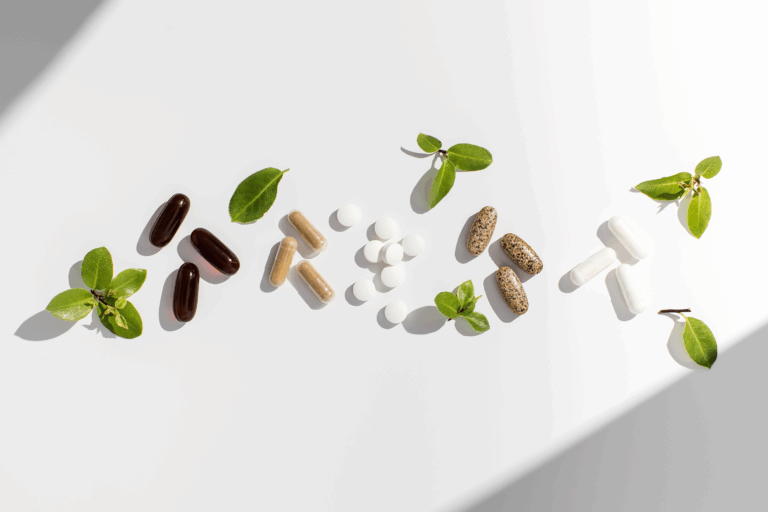Iron's Role in Oxygen Transportation and More
Iron’s Role in Oxygen Transportation and More
Iron is an essential mineral found both naturally in foods and in dietary supplements. It plays a critical role in the blood because it is found in two important proteins: hemoglobin and myoglobin. Hemoglobin is a protein found in erythrocytes (red blood cells) that supports transporting oxygen from the lungs to bodily tissues – it also gives blood its red color. Myoglobin is the protein that then works to disperse the oxygen through muscle tissue. Ultimately, iron absorption supports muscle metabolism and healthy connective tissue in addition to aiding in physical growth, neurological development, cellular function, and hormone synthesis.
Heme vs. Non-heme Iron
There are two forms of iron: heme and non-heme. It is important to distinguish between the two because they are not absorbed and utilized the same way in the body. Heme iron is only found in animal products like meat, seafood, and poultry.1 Non-heme iron is found in both animal products and plants like nuts, legumes, seeds, and some fortified grains. Non-heme iron is not utilized in the body as well as heme iron; non-heme has lower bioavailability. This is why vegetarian diets tend to require more iron for the same effect. Because the bioavailability from non-heme iron in a vegetarian diet is lower, the requirement for iron is greater. The bioavailability from iron in a typical vegetarian diet is approximately 10 percent, whereas the bioavailability of iron from a typical mixed Western diet is approximately 18 percent. Therefore, the requirement for iron is 1.8 times higher for individuals who do not eat meat.2 Breast milk contains highly bioavailable iron, which is sufficient for infants up to four months old.
The Recommended Daily Allowance (RDA) for iron is as follows:
- Infants 7-12 months: 11 mg
- Children: ranges from 8mg to 15 mg
- Females ages 14-18: 15 mg
- Females ages 19-50: 18 mg
- Females > 50 years old: 8 mg
- Men ages 19 and older: 8 mg
The Daily Value (DV) for iron is 18mg for adults and children four years of age and older.
Supplements may also be a viable and convenient source of iron. Frequently used forms of iron in supplements include ferrous and ferric iron salts. Approximately 14 to 18 percent of Americans use a supplement containing iron, including 60 percent of women who are lactating and 72 percent of women who are pregnant. It is important to note the dosage of an iron supplement because high doses of supplemental iron (45 mg/day or more) may cause digestive side effects such as nausea and constipation.
Iron Absorption
There are certain nutrients known to either help or hinder iron absorption. Vitamin C has been shown to enhance the bioavailability of non-heme iron.3 For vegans and vegetarians, incorporating foods high in vitamin C, such as yellow peppers, kale, and broccoli, in the diet may help with non-heme iron absorption. On the other hand, some polyphenols and phytates, found in grains and beans, may reduce the bioavailability of non-heme iron.4 Lastly, calcium has the potential to reduce the bioavailability of both heme and non-heme iron—although studies have found this inhibition is of a short duration and is very adaptable.5
Forms of Iron in the Body
Iron in the human body is mostly found in hemoglobin. The remaining is found in myoglobin in muscle tissue and in stored forms. Iron can be found in storage and transfer proteins in the form of ferritin in the liver, spleen, and bone marrow, and bound to transferrin, the main protein in blood that transports iron throughout the body. Hepcidin is a circulating peptide hormone that plays a key role in regulating the absorption and distribution of iron throughout the body.
Iron Deficiency & Anemia
Iron deficiency anemia (IDA) is the most common nutrient deficiency worldwide, with women and children being affected the most. Anemia is a state of insufficient healthy red blood cells that can lead to reduced oxygen flow to body tissues. IDA is the most advanced form of iron deficiency and can be detected by low hemoglobin and hematocrit levels in the blood. Iron deficiency erythropoiesis (red blood cell production) is less severe than IDA and not as easily detected with common assessments that individuals might get at a doctor’s visit, such as hemoglobin levels, which are usually within normal range in this iron deficiency state. In iron deficiency erythropoiesis, stored iron levels are depleted, resulting in low serum ferritin concentrations and low transferrin saturation.
To determine if iron levels are sufficient, it is important to get blood work done at the doctor’s office and to understand that some measures may not be sensitive or specific enough to fully illustrate an individual’s true iron status. It can be difficult to distinguish between iron levels circulating in the body versus iron actually absorbed and utilized— an issue often correlated with heme versus non-heme iron intake. This can then convolute proper diagnosis of iron deficiency. The most commonly used screenings for iron deficiency come from hemoglobin and hematocrit tests, while perhaps the most sensitive measures to detect for iron deficiency are those that measure iron storage and transport (serum ferritin and transferrin saturation).
The World Health Organization estimates that worldwide, one-third of women in the reproductive age, 40 percent of pregnant women, and over 40 percent of children under the age of five are anemic. Insufficient iron intake during pregnancy increases the risk of low infant birthweight, premature birth, low iron stores, and impaired cognitive and behavioral development. 1996-2006 NHANES data shows that 18 percent of pregnant women in the Unites States had iron deficiencies, so it is imperative that iron consumption is emphasized throughout prenatal care.6
Anemia of chronic disease, also known as anemia of inflammation, is the second most common type of anemia; it can be caused by inflammatory, infectious, and neoplastic diseases. Inflammatory cytokines upregulate hepcidin, disrupting iron homeostasis and diverting iron from the circulation to storage sites. This limits the amount of iron available for erythropoiesis.
Excessive iron intake can also cause issues in the body. The Tolerable Upper Intake Level (UL) for iron intake for the average adult is 45 mg/day.8 Hemochromatosis is a condition characterized by the mutation in the HFE gene, and it is associated with an excessive buildup of iron.7 If gone untreated, liver cirrhosis, hepatocellular carcinoma, heart disease, and impaired pancreatic function may result.
Iron is an essential mineral involved in one of the most foundational physiological processes in the body: the circulation of oxygen to cells, tissues, and organs. Recognizing heme and non-heme sources of iron is important for understanding and appreciating how this mineral is absorbed and utilized, as well as how it supports muscle strength, blood flow, and other important aspects of human health.
- Moustarah F, Mohiuddin SS. Dietary Iron. [Updated 2021 Apr 28]. In: StatPearls [Internet]. Treasure Island (FL): StatPearls Publishing; 2021 Jan-.
- Institute of Medicine (US) Panel on Micronutrients. Dietary Reference Intakes for Vitamin A, Vitamin K, Arsenic, Boron, Chromium, Copper, Iodine, Iron, Manganese, Molybdenum, Nickel, Silicon, Vanadium, and Zinc. Washington (DC): National Academies Press (US); 2001. 9, Iron. Available from: https://www.ncbi.nlm.nih.gov/books/NBK222309/
- Hallberg, L., Brune, M., & Rossander, L. (1989). The role of vitamin C in iron absorption. International journal for vitamin and nutrition research. Supplement = Internationale Zeitschrift fur Vitamin- und Ernahrungsforschung. Supplement, 30, 103–108.
- Gillooly, M., Bothwell, T. H., Torrance, J. D., MacPhail, A. P., Derman, D. P., Bezwoda, W. R., Mills, W., Charlton, R. W., & Mayet, F. (1983). The effects of organic acids, phytates and polyphenols on the absorption of iron from vegetables. The British journal of nutrition, 49(3), 331–342. https://doi.org/10.1079/bjn19830042
- Lönnerdal B. (2010). Calcium and iron absorption–mechanisms and public health relevance. International journal for vitamin and nutrition research. Internationale Zeitschrift fur Vitamin- und Ernahrungsforschung. Journal international de vitaminologie et de nutrition, 80(4-5), 293–299. https://doi.org/10.1024/0300-9831/a000036
- Mei, Z., Cogswell, M. E., Looker, A. C., Pfeiffer, C. M., Cusick, S. E., Lacher, D. A., & Grummer-Strawn, L. M. (2011). Assessment of iron status in US pregnant women from the National Health and Nutrition Examination Survey (NHANES), 1999-2006. The American journal of clinical nutrition, 93(6), 1312–1320. https://doi.org/10.3945/ajcn.110.007195
- Pietrangelo A. (2006). Hereditary hemochromatosis. Biochimica et biophysica acta, 1763(7), 700–710. https://doi.org/10.1016/j.bbamcr.2006.05.013
- Institute of Medicine (US) Panel on Micronutrients. Dietary Reference Intakes for Vitamin A, Vitamin K, Arsenic, Boron, Chromium, Copper, Iodine, Iron, Manganese, Molybdenum, Nickel, Silicon, Vanadium, and Zinc. Washington (DC): National Academies Press (US); 2001. 9, Iron. Available from: https://www.ncbi.nlm.nih.gov/books/NBK222309/







